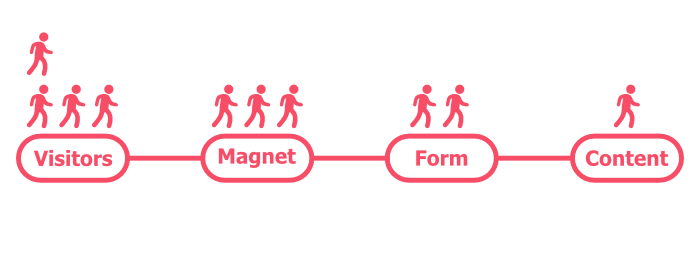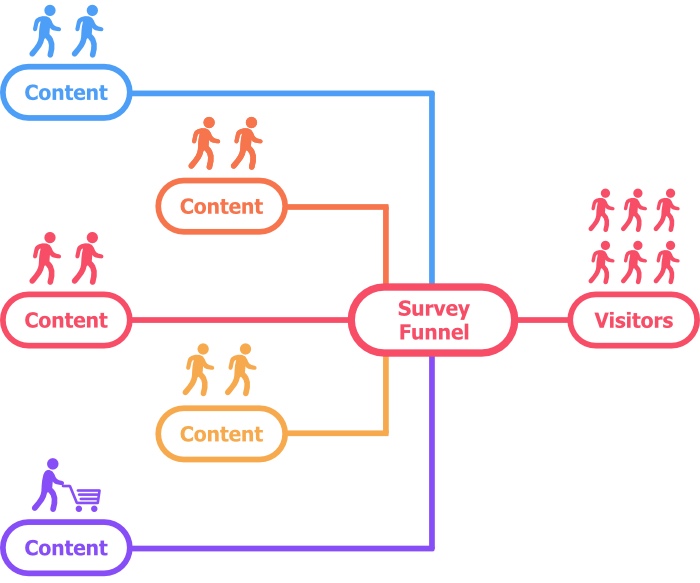Survey funnels are essential for businesses seeking to use customer feedback and insights to create more personalized customer experiences.
Below, we’ll be diving into what survey funnels are, how they can benefit your business, and (most importantly) how to get create a survey funnel for your business.
What is a survey funnel?
A survey funnel is the process of playing one or more surveys at key touchpoints throughout the customer journey.
These surveys have one goal, to segment your audience based on the feedback given for the purpose of delivering the most relevant product, service or content.
They can help increase conversions and identify qualified leads in all customer-centric activities, from email marketing to sales.
If we consider the RACE model, survey funnels would be part of the Act stage. Where we create content for leads to interact with, in hoping to move them into the conversion stage.
Difference between a survey funnel and a lead magnet
There’s a fair amount of conflicting information on survey funnels, which we believe creates more confusion than is necessary.
So we’d like to clear the air for you.
The job of a survey funnel is to capture information from leads and website visitors in order to direct them to content that is most relevant to them (personalization).
Lead magnets are useful pieces of content, created with the intention of capturing lead information in exchange for access to that content.
The difference here is in lead intent.
Lead magnets are only capturing leads who have a specific interest in the magnet content itself. They can be effective because they’re targeted, but there’s also a natural limit to how many leads they can generate.

Survey funnels cast a much wider net. They collect data from a more general audience, whilst also segmenting that audience into smaller targeted groups and directing them to personlized content.

What are the benefits of a survey funnel?
It’s no secret that understanding your audience is the cornerstone of successful marketing (and sales). Survey funnels provide an opportunity for you to learn everything you need to know about prospects at the earliest touchpoints.
Let’s get into more ways you can benefit below:
Personalized messaging: By understanding customer preferences, you can deliver the most relevant content possible and increase conversion rates.
Real-time feedback loop: Survey funnels collect continuous feedback, meaning you stay informed on your audience and identify changing preferences immediately.
Responsive improvements: Rather than waiting for periodic feedback, you can address concerns and rectify issues as soon as they arise.
Targeted recommendations: Learning as much as you can about potential customers means you can recommend the most relevant product for them, increasing the likelihood that they’d convert.
Reduce friction in the sales process: Collecting feedback on your sales funnel allows you to remove irrelevant steps and optimize those that encourage leads to convert.
Build stronger customer relationships: When customers see changes that were informed by their feedback, their commitment to your brand strengthens. Meaning they’re more loyal, and can become your advocates.
How to create a survey funnel
Before you get started creating a survey funnel, you need to have a rough idea of how you’re going to segment your leads.
One they’ve completed your survey, these lead segments (sometimes referred to as “buckets”) will be delivered personalized content to encourage them to convert.
So, take stock of what this content will be, e.g. whether it’s an email nurturing campaign a product landing page, and factor that into your survey funnel.
Step 1: Create your survey questions
The purpose of survey funnels is to plug any leaks in your lead conversion strategy, and the survey questions you ask should reflect this.
However, we recommend keeping your survey to a maximum of seven questions. Any longer and you’ll start seeing your drop-off rate increase.
Question wording will vary depending on your goals and industry, so instead of giving you exact questions, we’ll recommend what kind of data you’ll want to collect.
Identify pain points (in order to be the solution)
Your priority in this survey should be to identify a problem or challenge (pain points) that leads are experiencing. This will go a long way in helping you tailor content that promotes your product/ service/ offering as a solution to that problem.
This will also be the primary method by which you segment leads into buckets, and determine where they are sent once the survey is completed.
Ask why this problem hasn’t been solved (to help you qualify leads)
When leads are shopping around, it’s important to find out why they haven’t settled on a solution yet. You’ll find these answers often align with questions that qualify leads.
E.g. is there a budgetary restraint? are they looking for a specific feature? are they not being provided the level of support they need?
Not only can these questions help you disqualify leads you can’t convert, they can also highlight the leaks in your competitors’ funnels.
Collect demographic information (the more you know, the richer your data)
Now this step is completely optional, but knowing more about your leads are can really enrich your data.
These questions can cover everything form the industry they work in and their job role, to interests and content preferences.
But, a word of warning. Don’t ask too may of these questions, and only ask what you think will help you boost your conversion rate.
Any respondent is reluctant to hand over too much personal information, especially if they think it isn’t relevant to the task at hand.
Step 2: Use questions to create cluster segments
For the most part, questions that address lead problems and challenges will be used to define your segments.
This is because the content you direct them to will often act as the solution to that problem. Whether this is an email sequence, a product page, or a whitepaper.
You can, of course, use other questions to further inform how leads are segmented. But you’ll begin with those all important pain points.
So, let’s get into a basic example below.
We’ll use a multiple-choice question for this, but there are many other types of questions you can use.
Question: “In terms of [product/ service], what is the biggest problem or challenge you’re facing?”
Answers:
- A. No collaboration options
- B. Lack of customer support
- C. Too difficult to use
- D. Hidden costs
- E. Rising costs

This is a very simple example, but these answers allow us to infer the value these leads are seeking:
- A = Collaboration
- B = Accessibility and communication
- C = Usability and self-taught use
- D = Transparency
- E = Value for money
These values can then be used as the basis for our segments, which will inform what content we direct leads to upon completion.
Step 3: Configure your survey exit conditions (outcomes)
Your survey questions have now done their job, which is to segment your audience into specific groups.
And we know, using surveys to segment an audience isn’t breaking any new ground. What’s special about this strategy is what we do next.
Now we need to define an outcome for each of those groups as they exit your survey.
If we follow on from our above example, our outcomes may look a little something like this:
- A. No collaboration options –> Team Features Landing Page.
- B. Lack of customer support –> Testimonial showcasing your excellent support.
- C. Too difficult to use –> Page highlighting the ease of use of your product.
- D. Hidden costs –> Pricing page illustrating your transparent pricing.
- E. Rising costs –> Discount promotional page.
This example is a little close-ended, but there’s no reason your survey funnel couldn’t lead into a multi-step process, like an email nurturing campaign.
But what we’re trying to illustrate is; we’ve taken a general audience (with many wants and needs) and funnelled them into segments (with shared needs).
Each of those segments is then delivered a targeted piece (or series) of content, which is far more likely to encourage conversions.
Choosing the right survey software
Rather than suggest different survey software providers, we thought it best to tell you what features will help turn your funnel into a highly-converting machine.
So, let’s get into some of those below:
Exit page redirect
Redirect respondents to an external URL upon completion of your survey.
An absolutely essential feature if you need to send leads to a landing page once their response is submitted.
Question logic
Question logic allows you to create custom paths through your survey based on answer choices.
Another crucial feature, especially if you want segments to be based on multiple answers throughout your survey funnel.
Text piping (answer piping)
Pass text into questions, answers, and other survey fields.
Text piping allows you to pass lead information (such as names) into your survey, making questions and answers feel much more relevant. You can also use this feature to pass chosen answers into following question or answer fields.
Website embed
Embed your survey on a web page or inside a popup.
A must have feature if you want to capture data from website visitors. A fantastic setup for this use case would be to have your survey pop up after visitors spend a set time on your homepage.
Email invitations
Send bespoke email invitations for your survey funnel.
Email invitations allow you to retarget a previously engaged audience. Sending to an existing email list also means you don’t have to collect contact information in your survey funnel, which can increase response rates.
There are many more features we could include, but if we did, we’d be here all day. But, it’s worth noting that all these features are available with Shout ;).
Wrapping up
If you’re looking for a way to increase your conversion rate, creating a survey funnel is one of the best ways of doing so.
Not only can you learn more about your audience, you can deliver personalized content, build relationships, and boost sales.
If you think we’ve missed anything at all, don’t hesitate to get in touch with us.




